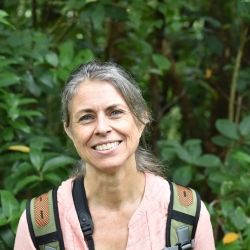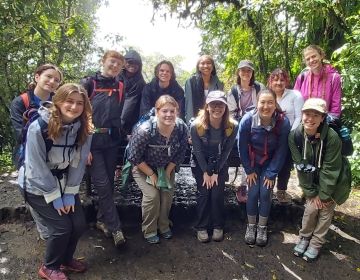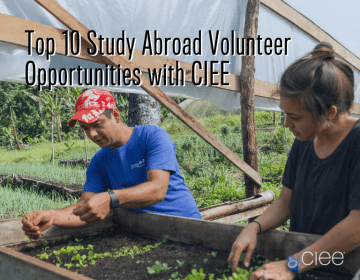Sustainability and the Environment: "Morning Walkabout"
It was Friday, February 22nd, and it was time to study freshwater ecosystems in Tropical Conservation Biology with Adam! But first, you know, it was time to reveal which internships the adventurers were going to be working on! It has to be revealed in a dramatic fashion.
Here's Adam moments before the climactic reveal
Don't stress out about it if you don't remember what all these internships are; we'll totally talk in more detail when the students start working working on them after the field trip.
In the mean time, the students had to contain their excitement to start their internships, because there was freshwater ecology that needed studying. In Adam's Tropical Conservation Biology class, they started with a short lecture that came with cool drawings to help them learn.
I'm not really convinced Adam didn't draw this one himself
As Adam explained, freshwater ecosystems are important because while these ecosystems contain only .01% of the Earth's water and cover only .8% of the Earth's surface, 33% of global vertebrate diversity is contained within freshwater ecosystems. Just about every amphibian identified is tied to freshwater ecosystems.
In case you're not sure what we're talking about here, freshwater ecosystems include rivers and streams, wetlands, and lakes and ponds. Streams and rivers are significant because they are "flow-through" systems, meaning something at the headwater will flow down through the whole system. While this is important to the ecosystem, it has a downside as well, specifically in the case of pollutant dispersion. If a headwater system is polluted, that pollutant will spread to the rest of the system, and it can be extremely hard to identify the source.
Well the lecture was super interesting and everything, but Adam decided that it would probably be good for the adventurers to see some of these ecosystems in person, don't you think?
So out the door they went...
Chandler is stoked to be out here in the sun
Adam decided to take the adventurers down by this cool hotel, in order to check out this artificial lake that the hotel built.
Not a bad view for a Friday, right?
Here, Adam taught the adventurers about the different biotic and abiotic zones contained in lakes and ponds. He talked about the Benthic zone, which has a lot of organisms breaking down organic material. The Pelagic zone is open water, with lots of different organisms (like carnivorous fish) utilising the habitat there. Finally, the littoral zone is where the terrestrial environment meets the lake; you might even call it the nursery of the lake, if you felt like making a metaphor out of it.
Adam took these cool kids down here for a reason. He wanted to talk about the threats to freshwater ecosystems, like invasive species, over-harvesting, pollution, habitat destruction, and climate change. There's this thing called eutrophication, which is a type of pollution that results in lots of organic material in the water, which causes plant life to explode; the plant life subsequently takes away oxygen and sunlight from the system, making life beneath the water's surface difficult.
Habitat destruction is a problem too-- flow modification can be found at this lake; the hotel dammed the stream to create the artificial body of water, forever affecting the habitat of the organisms that call the freshwater ecosystem home. Deforestation can also affect these habitats.
However, the thing Adam really wanted to talk about here was invasive species. In the picture above, you can see cattails and bamboo not-so-slowly colonising the lake, and these are both examples of invasive species.
Aislyn poses for a picture with the cattails
Once they'd talked a good bit about the freshwater ecology stuff, they decided to wander off into the forest to follow the little stream and see if they could learn anything else about it. Adam stopped every now and then along the way to teach the adventurers about the cool types of animals and plants around them.
On their little journey, Adam taught the adventures all about cecropia trees and their symbiotic relationship with Azteca ants. These cool ants make their home inside the tree, and in return for the free room and board, they defend the tree from herbivorous insects and vertebrates that might be thinking about eating the tree.
Here's Adam pointing at the Cecropia high above his head (you can't see it yet)
They also found a line of leaf-cutter ants and their giant colony, and they all crouched down to watch these little strong guys go.
The leaf-cutter ants certainly leave their mark on the forest floor
Just when they thought they'd found just about everything there was to find in this little jungle behind the hotel, Meg spotted a good-sized toad hiding out in the underbrush.
Mabel shows the little guy off to Aislyn
Here's Meg recounting heroically how she managed to discover the cool fella
Chandler considers kissing him just on the off-chance that the whole toad-prince thing is real
All in all, it was a pretty awesome morning. The adventurers got to learn about freshwater ecology, and then got to go on an adventure into the field to see these things with their own two eyes. I guess that's the benefit of studying abroad in Monteverde. Tell your friends.
Related Posts
Happy Earth Day: Today and Every Day
Happy Earth Day! Every April 22, this global event comes around to remind us how precious our planet is, what sustainable efforts we can make to protect Earth, and that... keep reading
Top 10 Study Abroad Volunteer Opportunities with CIEE
Have you ever wondered if you could volunteer abroad? Perhaps you're looking into study abroad programs that provide international volunteer opportunities. If you’re itching to study abroad and truly make... keep reading
Recycling Internship with ADI San Luis
Written by Maya Peske (Cornell College), Internship in Sustainability and the Environment The road from San Luis up to Monteverde is well known by all of the people in the... keep reading



